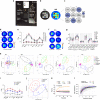Remote near infrared identification of pathogens with multiplexed nanosensors
- PMID: 33239609
- PMCID: PMC7689463
- DOI: 10.1038/s41467-020-19718-5
Remote near infrared identification of pathogens with multiplexed nanosensors
Abstract
Infectious diseases are worldwide a major cause of morbidity and mortality. Fast and specific detection of pathogens such as bacteria is needed to combat these diseases. Optimal methods would be non-invasive and without extensive sample-taking/processing. Here, we developed a set of near infrared (NIR) fluorescent nanosensors and used them for remote fingerprinting of clinically important bacteria. The nanosensors are based on single-walled carbon nanotubes (SWCNTs) that fluoresce in the NIR optical tissue transparency window, which offers ultra-low background and high tissue penetration. They are chemically tailored to detect released metabolites as well as specific virulence factors (lipopolysaccharides, siderophores, DNases, proteases) and integrated into functional hydrogel arrays with 9 different sensors. These hydrogels are exposed to clinical isolates of 6 important bacteria (Staphylococcus aureus, Escherichia coli,…) and remote (≥25 cm) NIR imaging allows to identify and distinguish bacteria. Sensors are also spectrally encoded (900 nm, 1000 nm, 1250 nm) to differentiate the two major pathogens P. aeruginosa as well as S. aureus and penetrate tissue (>5 mm). This type of multiplexing with NIR fluorescent nanosensors enables remote detection and differentiation of important pathogens and the potential for smart surfaces.
Conflict of interest statement
The authors declare no competing interests.
Figures





Similar articles
-
Quantitative Tissue Spectroscopy of Near Infrared Fluorescent Nanosensor Implants.J Biomed Nanotechnol. 2016 May;12(5):1035-47. doi: 10.1166/jbn.2016.2237. J Biomed Nanotechnol. 2016. PMID: 27305824 Free PMC article.
-
High Sensitivity Near-Infrared Imaging of Fluorescent Nanosensors.Small. 2023 Apr;19(14):e2206856. doi: 10.1002/smll.202206856. Epub 2023 Jan 6. Small. 2023. PMID: 36610045
-
Near-Infrared Fluorescence Lifetime Imaging of Biomolecules with Carbon Nanotubes.Angew Chem Int Ed Engl. 2023 Jun 12;62(24):e202300682. doi: 10.1002/anie.202300682. Epub 2023 Apr 20. Angew Chem Int Ed Engl. 2023. PMID: 36891826
-
Recent advances on applications of single-walled carbon nanotubes as cutting-edge optical nanosensors for biosensing technologies.Nanoscale. 2024 Sep 12;16(35):16344-16375. doi: 10.1039/d4nr01892c. Nanoscale. 2024. PMID: 39157856 Review.
-
Fluorescent Single-Walled Carbon Nanotubes for Protein Detection.Sensors (Basel). 2019 Dec 7;19(24):5403. doi: 10.3390/s19245403. Sensors (Basel). 2019. PMID: 31817932 Free PMC article. Review.
Cited by
-
Single-Walled Carbon Nanotubes as Fluorescent Probes for Monitoring the Self-Assembly and Morphology of Peptide/Polymer Hybrid Hydrogels.Nano Lett. 2022 Nov 23;22(22):9205-9214. doi: 10.1021/acs.nanolett.2c01587. Epub 2022 Oct 19. Nano Lett. 2022. PMID: 36259520 Free PMC article.
-
Prospects of NIR fluorescent nanosensors for green detection of SARS-CoV-2.Sens Actuators B Chem. 2022 Jul 1;362:131764. doi: 10.1016/j.snb.2022.131764. Epub 2022 Mar 30. Sens Actuators B Chem. 2022. PMID: 35370362 Free PMC article. Review.
-
Research Progress on Multiplexed Pathogen Detection Using Optical Biosensors.Biosensors (Basel). 2025 Jun 12;15(6):378. doi: 10.3390/bios15060378. Biosensors (Basel). 2025. PMID: 40558460 Free PMC article. Review.
-
Near-Infrared Fluorescent Single-Walled Carbon Nanotubes for Biosensing.Small. 2025 Jul;21(26):e2502542. doi: 10.1002/smll.202502542. Epub 2025 May 2. Small. 2025. PMID: 40317978 Free PMC article. Review.
-
A Polymer-Based Multichannel Sensor for Rapid Cell-Based Screening of Antibiotic Mechanisms and Resistance Development.ACS Appl Mater Interfaces. 2022 Jun 15;14(23):27515-27522. doi: 10.1021/acsami.2c07012. Epub 2022 May 31. ACS Appl Mater Interfaces. 2022. PMID: 35638721 Free PMC article.
References
-
- Willyard C. Drug-resistant bacteria ranked. Nature. 2017;543:15. - PubMed
-
- Cecconi M, Evans L, Levy M, Rhodes A. Sepsis and septic shock. Lancet. 2018;392:75–87. - PubMed
-
- Shohat N, et al. Hip and knee section, what is the definition of a periprosthetic joint infection (PJI) of the knee and the hip? Can the same criteria be used for both joints?: Proceedings of international consensus on orthopedic infections. J. Arthroplast. 2019;34:325–327. - PubMed
-
- Váradi L, et al. Methods for the detection and identification of pathogenic bacteria: past, present, and future. Chem. Soc. Rev. 2017;46:4818–4832. - PubMed
Publication types
MeSH terms
Substances
LinkOut - more resources
Full Text Sources
Other Literature Sources
Medical
Molecular Biology Databases
Miscellaneous

